Racing on the vertical. How, why and where do Lakhta Centre's elevators go
To get to the highest inhabited floors of Lakhta Center is a matter of seconds. On the shuttle, the path to the observation platform will take 45 seconds. 45 seconds - and you are already above the city, above the clouds, above the Petersburg rain and fog. Is it possible to regret that the trip ended so quickly? Yes, after all, the elevator will be lucky to not want to leave it. Other elevators that make up the vertical transport system of Lakhta Center also differ from their fellows as well - in structure, capacity, and functionality. Let's take a closer look at them.
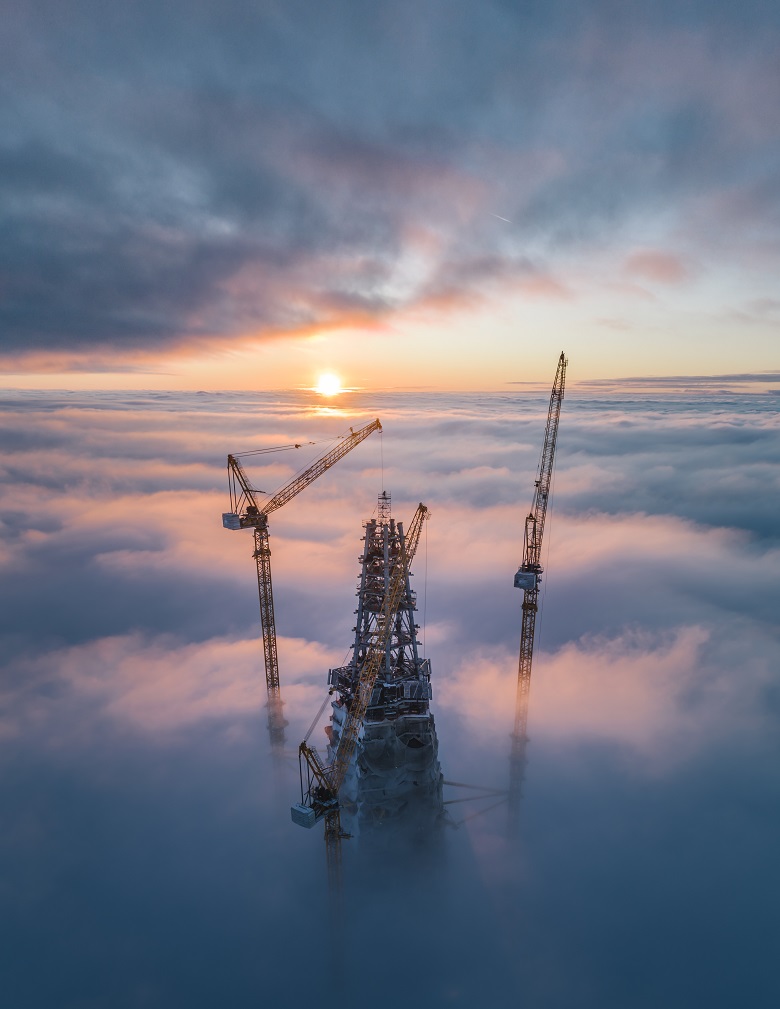
Not an obvious side functionality of the Lakhta Center elevators - trips for sunny weather. Photo by Mikhail Proskalov
The tower will have 40 elevators. All rolling stock is grouped in three transport zones.
Six two-level elevators - Double Deck will serve the lower zone from the 1st to the 32nd floors. Lifts of the middle group can be reached from the 31st to the 52nd - they do not stop on the floors of the lower zone. In addition, up to 51-52 floors, there will be four more double express elevators going to, which can only be reached at the final stops. Finally, on the upper level from the 51st to the 80th floor, five more double elevators run. Transport zones will be interconnected by skylobby double-deck interchange.

Transfer floors - skylobby. In addition to the main function, they serve as foyer-recreations.
')
However, this is not the entire vertical transport complex of the Supertoll. The flagship is a high-speed tourist express, departing from the 3rd floor and finishing at the 83rd, that is, at the first level of the observation platform (the height of the rise is 344.4 m). Intermediate stop - a restaurant on the 75th floor.

(Clickable)
How to understand such a complex system of transport zones and transfers, especially if the person is for the first time in Lakhta Center?
Understand is not required. In front of the lift hall, visitors to the tower will be greeted by the terminals of the automatic group control system PORT. Simply click on the touch screen button of the desired floor, and the system will point to which elevator of which group you need to go. In the cabs there will be no control panels with buttons at all - only hidden remotes for personnel. All manages PORT.
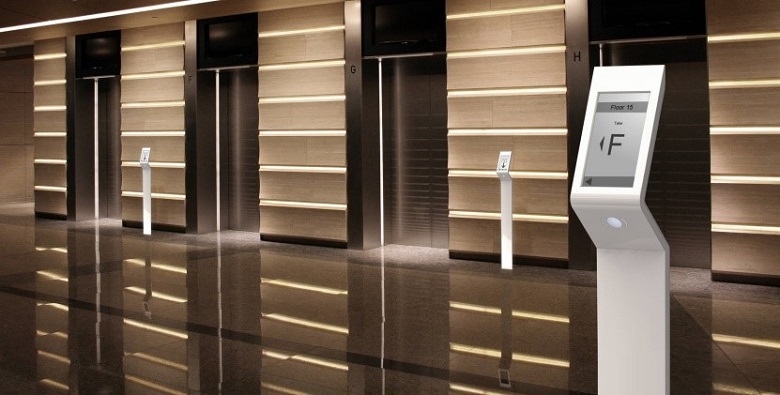
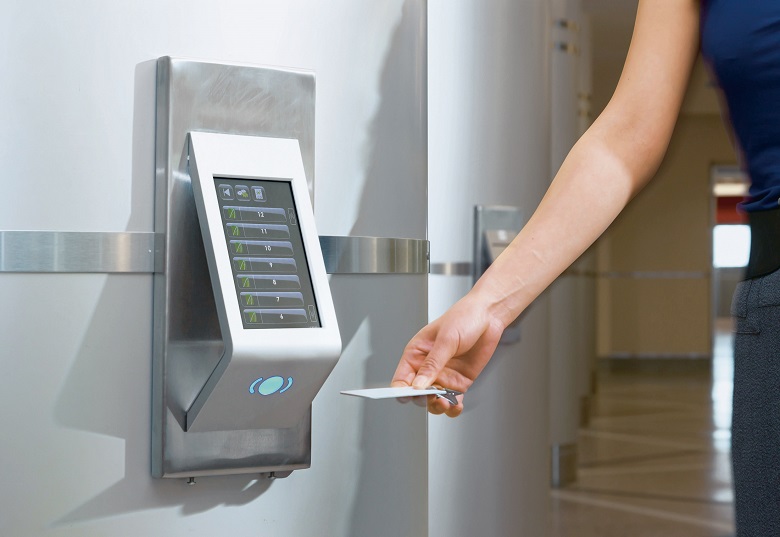
Schindler PORT technology
It is easy to imagine what queues would accumulate in the elevator halls, if the elevators had worked traditionally. After all, the total population of the Lakhta Center tower is about 5 thousand people.
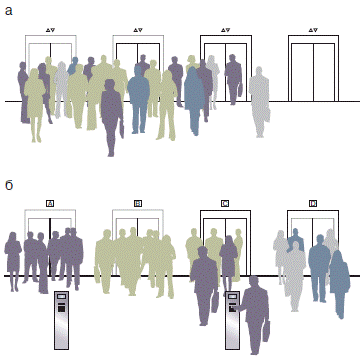
Selection of the destination floor in the traditional control system (a) and in the control system with the choice of the destination floor (b)
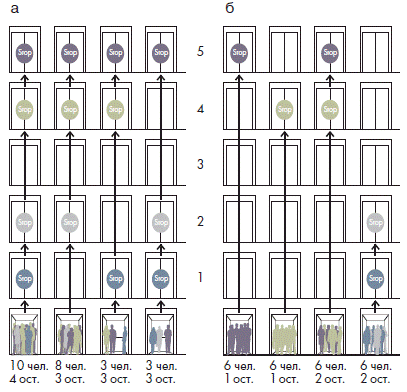
The working pattern of the elevator group with the traditional control system (a) and with the control system with the choice of the destination floor (b)
Thanks to automation, the waiting time for passenger elevators will not exceed 29 seconds. Together with the trip itself, the time required to reach the floors of the lower and middle zones will be in the range of 80-100 seconds, and up to the upper - 100-150 seconds.
The speed of the elevators themselves varies in different altitudinal zones of the Lakhta Center skyscraper - from 4 to 7 m / s for most of the cabins and reaches 8 m / s - for example, in the case of a tourist express. These are, of course, not record-breaking indicators, but far from 1-1.6 m / s, with which elevators of ordinary residential high-rises move. In defense of the latter, they also made a significant step from the speed of the Soviet era elevators from 0.71 m / s.
In the transport system of Lakhta Center use elevators with two rigidly fixed cabins one above the other (Double Deck). This design allows you to double the bandwidth. This is a powerful plus that outweighs all the minuses of the “double-decker” solution.
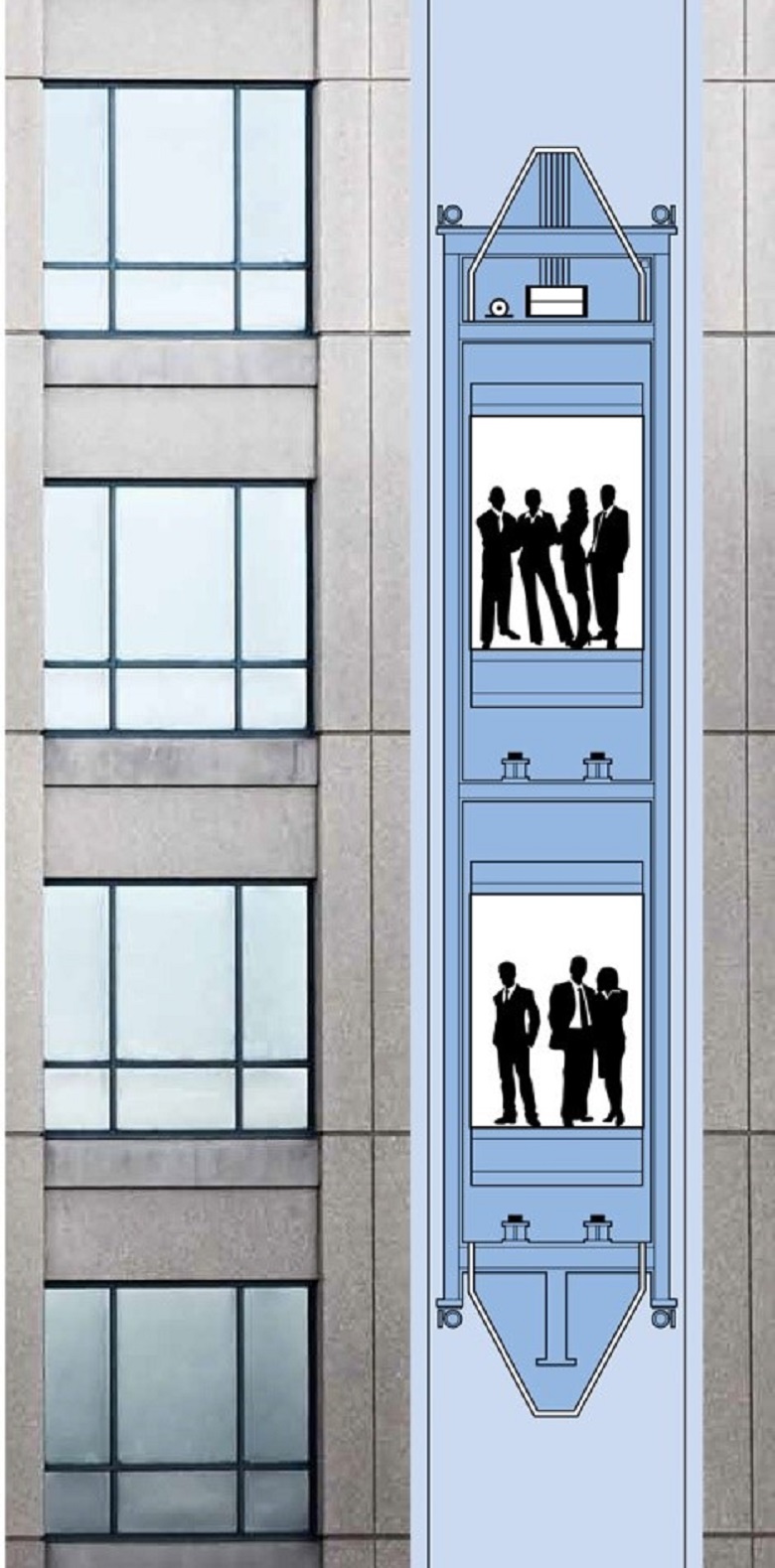
There are about a hundred buildings in the world where cabins of this type are used. All of them are designed individually - due to the different sizes of elevator shafts, the engine room and other specific features of the buildings.
Double-deck elevators are a heavy, large-capacity “fleet” that effectively operates during peak hours. In addition, not only increased payload, but also a reduced number of stops - landing / disembarking takes place immediately from two floors.
Special thanks to the two-level elevators for saving usable space and reducing the volume of construction due to the compact placement of the cabins one above the other. A single-deck cabin of similar area and carrying capacity would require double the size of the elevator shaft. Imagine the required core size of the building in this case?
But there are also disadvantages to the beautiful Double Deck.
Of the "little things" - the size of the winches for double-ledgers occupy a relatively larger percentage of the area of the engine room.
Here for example twin winch lift:

The capacity of the cabin lifted by this winch is 1800 kg, the speed is 6 m / s. The weight of the winch itself is 6 tons.
And here is the Double Deck elevator winch:

Elevator for two cabins with a carrying capacity of 1,800 kg each, lifting speed - 10 m / s, winch weight - 18 tons!
But this is the main thing: transfer floors are necessary in order to carry out a landing and disembarkation from a two-level cabin at the final stops. Remember the double-decker skylobby? That is the reason for their appearance.
As a result, the installation of at least one two-tier cab condemns the fact that the rest of the elevators in this group will be Double Deck. It makes no sense to build a two-story interchange space to put just a pair of double-fenders. For example, in Lahta Center of elevators of this type - fifteen.
Yes, the elevators in Lakhta Center are quiet and smooth, which is due to the use of roller shoes - the cabin does not slide along the guides, but rolls.

Correspondents of the shopping mall St. Petersburg put a coin in the cabin of a similar elevator on the edge for the experiment. It can be seen that even at the moment of launch it stands as glued
In the comments there were questions about whether elevator cables are being used now and there were suggestions that they are not needed anymore, since the cab is traveling along the tracks. This is not so - the cables have not gone away yet; on the gif, you can consider the system of steel cables.
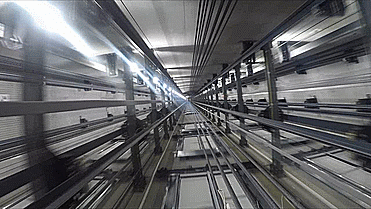
Ride in the elevator shaft
There are no technical problems with the length of the cable for elevators of a skyscraper either - the question of the weight and length of the rope arises for the time being an insoluble task only in the case of a cosmolift. The tower of Lakhta Center, although high, still did not grow to unsolvable tasks.
Of course, elevators in Lakhta are modern equipment, energy consumption corresponds to class A. An interesting element is winches with energy recovery during braking, which returns up to 30% of electricity to the system.

Special attention was paid to safety when designing a vertical transport system. All high-altitude and high-speed elevators are located inside the main supporting structure of the tower - the rigid body of the core, in the space of the skyscraper that is most protected from any cataclysms.

Supermassive core - the place where the complex elevators will be located

In the diagram
Outside the core there are only panoramic elevators plying in frame glass mines between the levels of observation platforms and low-freight - with a loading capacity of 100 kg - intended for serving the kitchens of restaurants and therefore nicknamed “borschevoza”.

The tension of all the cables holding each cabin is controlled by special sensors that stop the elevator when at least one rope is loosened. But even if we imagine an unrealistic situation: all the cables broke at the same time, the electronics refused and the cockpit went into uncontrolled descent mode, then ... nothing terrible will happen. Remember catchers and sensors exceeding the rated speed, invented two centuries ago. They are still working. And even spectacular fountains of sparks during braking, as in popular action movies, will not happen - due to special ceramic linings.
The elevator control system even tracks the deflection angle of the building from the vertical, and when elevating the critical value it turns off the elevators.
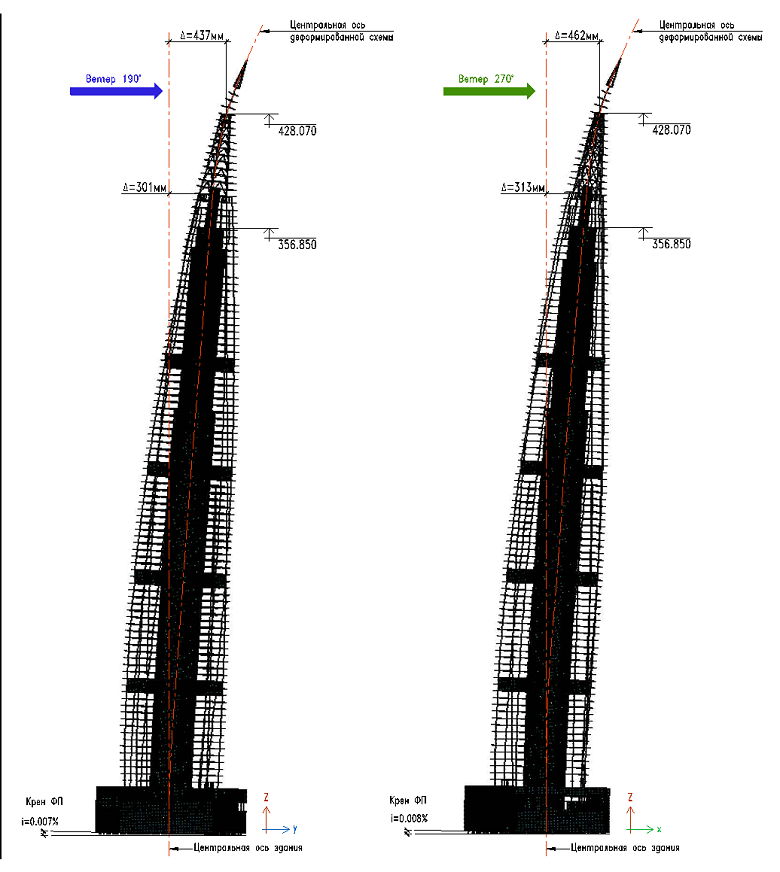
But all this is extreme situations, the probability of which is calculated in fractions of a percent. But technological difficulties arose in the process of designing a skyscraper's vertical transport system regularly, and rather unusual solutions were used to solve them.
For example, to combat the piston effect in the mines of express elevators, when the cab, moving at high speed, creates powerful vertical air flows in front of it, it was necessary to provide special openings between adjacent mines.
In order to reduce the effect of thrust arising in the mine due to the difference in temperature and pressure, protective membranes are installed that cover the entire cross section of the shaft.
Sometimes an elevator is more than a means of getting from point A to point B. Here, for example, is an exceptional story that you just can't ignore:

On the gif - a tour in the office of the Czech industrialist Tomas Bata. The cabinet itself is located in the elevator. Dad used it to work alongside the employees of his shoe factory - today with lawyers, tomorrow - with engineers, the day after tomorrow - in the cutting workshop ... That's for sure - Dad.
But back to Lakhta Center.
In the skyscraper there is a special group of super-important elevators. In life, they look and work like ordinary elevators. But in case of emergency, they become a good help to combat the elimination of the incident.
In comments earlier, opinions were expressed that a fire in a high-rise is a special case: firefighters cannot abandon the stairs and come to the rescue "through the window."
Car ladders are really so long: 90 meters is the ceiling and they are unlikely to ever grow up again. But for the "attack" restrictions are not - they are served from the window below - into the window above.
The main ways of evacuating some and coming to the aid of others are non-smokeable stairs in the core of the tower. The core, having the highest existing fire resistance limit, is a safe and secure path of retreat. As for the offensive, with a hypothetical fire at the very top of the tower, the walking path to the top will take some time.
In emergency conditions, when the minutes of the road, special lifts come to the rescue. They, like their load-lifting comrades, when a fire signal arrives, go down to the first floor and disembark passengers without reacting to anyone’s calls. But firefighters have a special unified key to control special cabins.
In the tower of a skyscraper - several such elevators, including moving at a speed of 8 m / s and delivering even to the top in less than a minute.
Mines of fire-prevention elevators have special locks, where, in the case of an emergency, air is supplied — this prevents fire and combustion products from entering directly to the elevators.
Firefighters get into the vestibule first, and only from there - into the rooms where there is a fire. If it is not possible to get out of the vestibule, firefighters in the elevator can go down to the floor below and then climb the unsteady staircase in the core.

(Clickable)
There are other special elevators. For example, a separate elevator is designed to transport IT equipment to the server.
And guaranteed the most popular in the near future - the shuttle to the observation platform Lakhta Center. Its walls are equipped with LED panels, and a short 45-second trip on it itself promises to be an adventure. An attraction of this kind is arranged in one of the elevators of the WTC tower - you can see the entire history of the construction of New York.
In this elevator, even the inveterate elevator-claustrophobic will gladly ride.
Unfortunately, the details of what will be shown when traveling on a shuttle in Lakhta Center, have not yet been disclosed. One thing is good - wait just a little longer.
***
The first part of the article about elevators - Express to the clouds. How does the system of vertical transport in modern skyscrapers.
***
Alexander Sergeevich Orlov, Head of Vertical Transport, Lakhta Center, Alexander Vitalyevich Gladilin, Chief Fire Safety Specialist, Lakhta Center, and Andrei Korolev, Project Manager, Lakhta Center for Vertical Transport, Samsung C & T. Thanks for the help.

Not an obvious side functionality of the Lakhta Center elevators - trips for sunny weather. Photo by Mikhail Proskalov
Lift fleet
The tower will have 40 elevators. All rolling stock is grouped in three transport zones.
Six two-level elevators - Double Deck will serve the lower zone from the 1st to the 32nd floors. Lifts of the middle group can be reached from the 31st to the 52nd - they do not stop on the floors of the lower zone. In addition, up to 51-52 floors, there will be four more double express elevators going to, which can only be reached at the final stops. Finally, on the upper level from the 51st to the 80th floor, five more double elevators run. Transport zones will be interconnected by skylobby double-deck interchange.

Transfer floors - skylobby. In addition to the main function, they serve as foyer-recreations.
')
However, this is not the entire vertical transport complex of the Supertoll. The flagship is a high-speed tourist express, departing from the 3rd floor and finishing at the 83rd, that is, at the first level of the observation platform (the height of the rise is 344.4 m). Intermediate stop - a restaurant on the 75th floor.

(Clickable)
How to understand such a complex system of transport zones and transfers, especially if the person is for the first time in Lakhta Center?
How to find the right lift
Understand is not required. In front of the lift hall, visitors to the tower will be greeted by the terminals of the automatic group control system PORT. Simply click on the touch screen button of the desired floor, and the system will point to which elevator of which group you need to go. In the cabs there will be no control panels with buttons at all - only hidden remotes for personnel. All manages PORT.


Schindler PORT technology
It is easy to imagine what queues would accumulate in the elevator halls, if the elevators had worked traditionally. After all, the total population of the Lakhta Center tower is about 5 thousand people.

Selection of the destination floor in the traditional control system (a) and in the control system with the choice of the destination floor (b)

The working pattern of the elevator group with the traditional control system (a) and with the control system with the choice of the destination floor (b)
100 seconds to the clouds
Thanks to automation, the waiting time for passenger elevators will not exceed 29 seconds. Together with the trip itself, the time required to reach the floors of the lower and middle zones will be in the range of 80-100 seconds, and up to the upper - 100-150 seconds.
The speed of the elevators themselves varies in different altitudinal zones of the Lakhta Center skyscraper - from 4 to 7 m / s for most of the cabins and reaches 8 m / s - for example, in the case of a tourist express. These are, of course, not record-breaking indicators, but far from 1-1.6 m / s, with which elevators of ordinary residential high-rises move. In defense of the latter, they also made a significant step from the speed of the Soviet era elevators from 0.71 m / s.
About doubles
In the transport system of Lakhta Center use elevators with two rigidly fixed cabins one above the other (Double Deck). This design allows you to double the bandwidth. This is a powerful plus that outweighs all the minuses of the “double-decker” solution.

There are about a hundred buildings in the world where cabins of this type are used. All of them are designed individually - due to the different sizes of elevator shafts, the engine room and other specific features of the buildings.
Double-deck elevators are a heavy, large-capacity “fleet” that effectively operates during peak hours. In addition, not only increased payload, but also a reduced number of stops - landing / disembarking takes place immediately from two floors.
Special thanks to the two-level elevators for saving usable space and reducing the volume of construction due to the compact placement of the cabins one above the other. A single-deck cabin of similar area and carrying capacity would require double the size of the elevator shaft. Imagine the required core size of the building in this case?
But there are also disadvantages to the beautiful Double Deck.
Of the "little things" - the size of the winches for double-ledgers occupy a relatively larger percentage of the area of the engine room.
Here for example twin winch lift:

The capacity of the cabin lifted by this winch is 1800 kg, the speed is 6 m / s. The weight of the winch itself is 6 tons.
And here is the Double Deck elevator winch:

Elevator for two cabins with a carrying capacity of 1,800 kg each, lifting speed - 10 m / s, winch weight - 18 tons!
But this is the main thing: transfer floors are necessary in order to carry out a landing and disembarkation from a two-level cabin at the final stops. Remember the double-decker skylobby? That is the reason for their appearance.
As a result, the installation of at least one two-tier cab condemns the fact that the rest of the elevators in this group will be Double Deck. It makes no sense to build a two-story interchange space to put just a pair of double-fenders. For example, in Lahta Center of elevators of this type - fifteen.
Is the ride comfortable?
Yes, the elevators in Lakhta Center are quiet and smooth, which is due to the use of roller shoes - the cabin does not slide along the guides, but rolls.

Correspondents of the shopping mall St. Petersburg put a coin in the cabin of a similar elevator on the edge for the experiment. It can be seen that even at the moment of launch it stands as glued
In the comments there were questions about whether elevator cables are being used now and there were suggestions that they are not needed anymore, since the cab is traveling along the tracks. This is not so - the cables have not gone away yet; on the gif, you can consider the system of steel cables.

Ride in the elevator shaft
There are no technical problems with the length of the cable for elevators of a skyscraper either - the question of the weight and length of the rope arises for the time being an insoluble task only in the case of a cosmolift. The tower of Lakhta Center, although high, still did not grow to unsolvable tasks.
Elevator returns electricity
Of course, elevators in Lakhta are modern equipment, energy consumption corresponds to class A. An interesting element is winches with energy recovery during braking, which returns up to 30% of electricity to the system.

The safest place
Special attention was paid to safety when designing a vertical transport system. All high-altitude and high-speed elevators are located inside the main supporting structure of the tower - the rigid body of the core, in the space of the skyscraper that is most protected from any cataclysms.

Supermassive core - the place where the complex elevators will be located

In the diagram
Outside the core there are only panoramic elevators plying in frame glass mines between the levels of observation platforms and low-freight - with a loading capacity of 100 kg - intended for serving the kitchens of restaurants and therefore nicknamed “borschevoza”.

If the cable breaks
The tension of all the cables holding each cabin is controlled by special sensors that stop the elevator when at least one rope is loosened. But even if we imagine an unrealistic situation: all the cables broke at the same time, the electronics refused and the cockpit went into uncontrolled descent mode, then ... nothing terrible will happen. Remember catchers and sensors exceeding the rated speed, invented two centuries ago. They are still working. And even spectacular fountains of sparks during braking, as in popular action movies, will not happen - due to special ceramic linings.
The elevator control system even tracks the deflection angle of the building from the vertical, and when elevating the critical value it turns off the elevators.

But all this is extreme situations, the probability of which is calculated in fractions of a percent. But technological difficulties arose in the process of designing a skyscraper's vertical transport system regularly, and rather unusual solutions were used to solve them.
For example, to combat the piston effect in the mines of express elevators, when the cab, moving at high speed, creates powerful vertical air flows in front of it, it was necessary to provide special openings between adjacent mines.
In order to reduce the effect of thrust arising in the mine due to the difference in temperature and pressure, protective membranes are installed that cover the entire cross section of the shaft.
Special Purpose Lifts
Sometimes an elevator is more than a means of getting from point A to point B. Here, for example, is an exceptional story that you just can't ignore:

On the gif - a tour in the office of the Czech industrialist Tomas Bata. The cabinet itself is located in the elevator. Dad used it to work alongside the employees of his shoe factory - today with lawyers, tomorrow - with engineers, the day after tomorrow - in the cutting workshop ... That's for sure - Dad.
But back to Lakhta Center.
In the skyscraper there is a special group of super-important elevators. In life, they look and work like ordinary elevators. But in case of emergency, they become a good help to combat the elimination of the incident.
In comments earlier, opinions were expressed that a fire in a high-rise is a special case: firefighters cannot abandon the stairs and come to the rescue "through the window."
Car ladders are really so long: 90 meters is the ceiling and they are unlikely to ever grow up again. But for the "attack" restrictions are not - they are served from the window below - into the window above.
The main ways of evacuating some and coming to the aid of others are non-smokeable stairs in the core of the tower. The core, having the highest existing fire resistance limit, is a safe and secure path of retreat. As for the offensive, with a hypothetical fire at the very top of the tower, the walking path to the top will take some time.
In emergency conditions, when the minutes of the road, special lifts come to the rescue. They, like their load-lifting comrades, when a fire signal arrives, go down to the first floor and disembark passengers without reacting to anyone’s calls. But firefighters have a special unified key to control special cabins.
In the tower of a skyscraper - several such elevators, including moving at a speed of 8 m / s and delivering even to the top in less than a minute.
Mines of fire-prevention elevators have special locks, where, in the case of an emergency, air is supplied — this prevents fire and combustion products from entering directly to the elevators.
Firefighters get into the vestibule first, and only from there - into the rooms where there is a fire. If it is not possible to get out of the vestibule, firefighters in the elevator can go down to the floor below and then climb the unsteady staircase in the core.

(Clickable)
There are other special elevators. For example, a separate elevator is designed to transport IT equipment to the server.
And guaranteed the most popular in the near future - the shuttle to the observation platform Lakhta Center. Its walls are equipped with LED panels, and a short 45-second trip on it itself promises to be an adventure. An attraction of this kind is arranged in one of the elevators of the WTC tower - you can see the entire history of the construction of New York.
In this elevator, even the inveterate elevator-claustrophobic will gladly ride.
Unfortunately, the details of what will be shown when traveling on a shuttle in Lakhta Center, have not yet been disclosed. One thing is good - wait just a little longer.
***
The first part of the article about elevators - Express to the clouds. How does the system of vertical transport in modern skyscrapers.
***
Alexander Sergeevich Orlov, Head of Vertical Transport, Lakhta Center, Alexander Vitalyevich Gladilin, Chief Fire Safety Specialist, Lakhta Center, and Andrei Korolev, Project Manager, Lakhta Center for Vertical Transport, Samsung C & T. Thanks for the help.
Source: https://habr.com/ru/post/371087/
All Articles